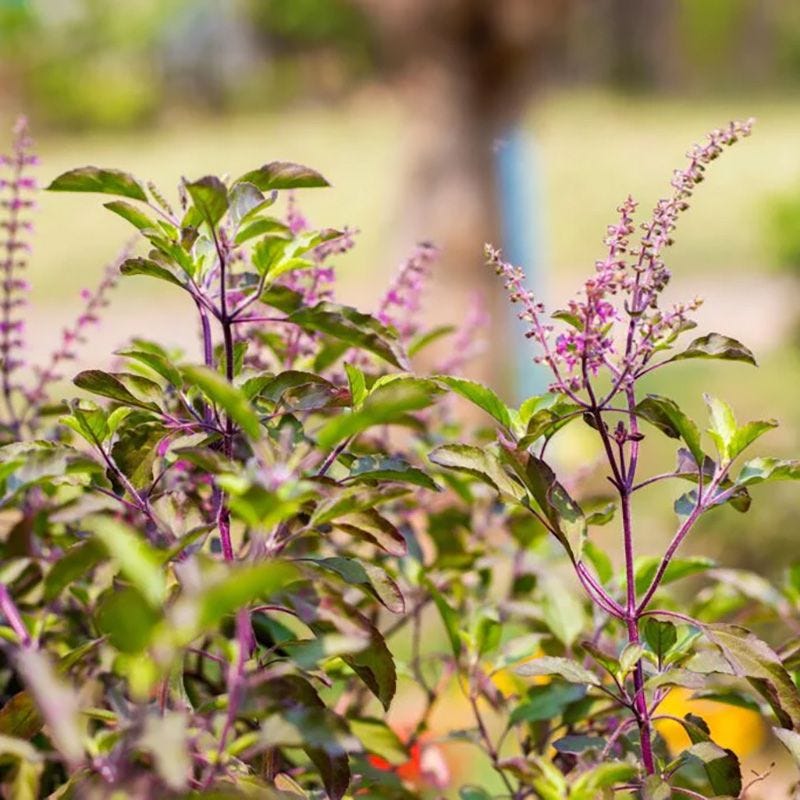Holy basil, or Tulsi is a flowering plant in the mint family that’s long been revered for its broad spectrum of medicinal properties in its native Indian subcontinent. Relied upon for centuries in the traditional Indian medicine system, Ayurveda, Holy basil has become increasingly popular in Western cultures.
Herb of Many Names & Much History
Queen of the Herbs, The Elixir of Life, Liquid Yoga, Mother Medicine of Nature, red holy basil, sacred basil, sacred purple basil, hot basil.... though it goes by many names, this Ayurvedic herb is one and the same, packed with phytochemicals that are purported to support the body in maintaining a state of optimum vitality. It is also a potent adaptogen.
As a science of life and the world's oldest medical system, Ayurveda takes a holistic approach to health and disease. By focusing on healthy lifestyle practices every day, the Ayurvedic approach promotes wellness. These practices include eating fresh, minimally processed foods, detoxification practices, and consumption of adaptogenic herbs that may help maintain balance in the midst of a variety of stressors. (Learn more about adaptogens here.) The emerging science on Tulsi, which reinforces ancient Ayurvedic wisdom, suggests that Tulsi is a tonic for the body, mind and spirit that offers solutions to many modern day stressors.
Tulsi versus Basil
Tulsi is an aromatic shrub that is thought to have originated in north central India, and now grows as a native plant throughout the Eastern world tropics. Though Tulsi (Ocimum tenuiflorum) and Mediterranean basil (Ocimum basilicum) are two different species of plants, they both belong to the mint family and are often referred to as one and the same herb – which they are not!
Basil is a staple herb used in Mediterranean dishes. Available in dozens of varieties, most offer a sweet, fragrant aroma, while flavors balance sweet and savory, with hints of mint, anise, and black pepper. It is most often used to flavor sauces, soups, and salads. While basil and Holy basil may have similarities of flavor and aroma, they also have distinct differences, and should not be substituted one for the other. It’s best to use the herb specified in your recipe.
Culinary Uses of Holy Basil
Like most herbs, Holy basil is available in a number of varieties. All varieties are astringent, pungent, warm and slightly sweet, with notes of peppermint, cloves, licorice, or lemon. Rama
Tulsi has a flavor profile that is spicier or clove-like, while the Vana variety is more fragrant and sweeter, with an anise taste. Krishna Tulsi is crisp and peppery. As with many herbs, it’s recommended that you use whole Tulsi leaves or tear them into smaller pieces before adding to a dish. If using dried Tulsi, rehydrate for 10-15 minutes prior to adding.
In Western cultures, Holy basil is most often used in teas, but this intense herb also lends fire to stir-fries (especially Thai), curries, noodles, fish, tofu, and a great variety of fruits and vegetables, including: baby corn, bamboo shoots, bean sprouts, broccoli, cabbage, carrots, celery, coconut milk, eggplant, green beans, mango, mushrooms, onions, pineapple, potatoes, radishes, scallions, shallots, snap peas, tomatoes, and zucchini.
Though often paired with fish, pork and tofu, Tulsi pairs well with proteins like beef, cashews, chicken, duck and eggs. Seasonings that complement Holy basil include: chili peppers, cilantro, cumin, curries, fish sauce, galangal, garlic, ginger, lemongrass, lemon juice, lime juice, makrut lime, mint, red pepper flakes, soy sauce, tamarind, turmeric and vanilla.
Drinking Tulsi Teas
All parts of the plant, and particularly its leaves and purple flowers, are considered beneficial by Ayurvedic practitioners. To make your own tea, pour boiling water over our organic Holy basil leaves and flowers and brew it for up to 10 minutes, similar to how you would make other teas. One of our stainless steel tea strainers makes the process easy. You can also make your own tea bags by filling our unbleached paper tea bags or reusable silicone infusers. After soaking them in boiling water, strain off the solids and drink the leftover liquid. Tulsi can also be eaten raw, if you don’t object to its somewhat bitter, spicy flavor.
Not only is Tulsi a powerhouse herb on its own, it works synergistically with other Ayurvedic adaptogenic herbs, such as turmeric and Ashwagandha, making it the perfect enhancer for any tea or supplement. That’s why Holy basil is included in many Ayurvedic formulas – to get the most benefit of key herbs and spices for deeper nourishment. We carry a large selection of these Tulsi-enhanced blended teas to appeal to a variety of individual needs and tastes.
Many Ways to Enjoy Tulsi
Once you’ve tried Holy basil as a tea and in your culinary adventures, perhaps you’ll decide to expand your use of Tulsi. In addition to teas and herbs, we offer a variety of Holy basil supplements. Whether you enjoy Tulsi tea or supplements, we believe you will enjoy the uplifting warm, and nourishing energy of this long-revered Ayurvedic herb.














